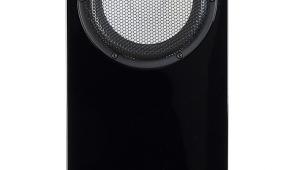Dali Ikon 6 Mk2 (£1199)
 Awarded EISA Loudspeaker of 2010-11 [see HFN, ’Oct 10], the latest version of Dali’s Ikon 6 may be relatively easy on the wallet, but you wouldn’t believe it to look at it. OK, it has a vinyl finish (this comes in a choice of black, light walnut or white) rather than a proper wood veneer. But most customers will surely consider that to be a fair exchange for what is a large cabinet at 1028mm tall, equipped with twin 6.5in reflex-loaded bass-mid drivers – the lower of which is rolled off gently above 700Hz – and Dali’s trademark twin-tweeter module.
Awarded EISA Loudspeaker of 2010-11 [see HFN, ’Oct 10], the latest version of Dali’s Ikon 6 may be relatively easy on the wallet, but you wouldn’t believe it to look at it. OK, it has a vinyl finish (this comes in a choice of black, light walnut or white) rather than a proper wood veneer. But most customers will surely consider that to be a fair exchange for what is a large cabinet at 1028mm tall, equipped with twin 6.5in reflex-loaded bass-mid drivers – the lower of which is rolled off gently above 700Hz – and Dali’s trademark twin-tweeter module.
This module comprises a 28mm soft dome unit and isodynamic supertweeter (which Dali calls a ribbon but isn’t). The former takes over from the active bass-mid driver at 2.6kHz and hands over to the planar supertweeter at 14kHz. A split crossover allows a choice of bi-wiring or bi-amping, with.
This tweeter double-act better maintains off-axis output, allowing the Ikon 6 to be aligned, as Dali recommends, firing straight down the room as opposed to being toedin to face the listening position. This reduces the spectral disparity between the speaker’s direct sound and that reaching the listening seat from the first sidewall reflection – a psychoacoustic strategy that results in a larger-scale stereo image and improved dynamic heft.
A speaker this tall and narrow with a high centre of gravity (it’s just 182mm wide and, according to Dali, is aimed at those with midsized to large listening rooms) is easy to knock over, so the company provides bolt-on metal feet which carry the supplied mounting spikes outboard of the cabinet base, improving stability.
AIRY AND REFINED
The old Ikon 6’s stock in trade was a big, open sound with free-ranging dynamics. Imaging was never cardboard cut-out precise but more than made up for with threedimensional solidity. If memory serves, this new model is a chip off the old block but with a tad more refinement. On Stravinsky’s A Soldier’s Tale, the opening track of High Definition Tape Transfers’ 24/96 download, it generated a large, airy acoustic that would put many a more costly rival to shame. Although the image focus was a little soft, the rawness and vitality of the performance still came across.
On David Bowie’s ‘Bewlay Brothers’ from the remastered Hunky Dory [EMI 724 3 521899 0 8], the softening had the welcome effect of preventing the power acoustic guitar chords in the chorus from searing your eardrums, but a little of the sparkle in the quieter moments was missing.
On the simply recorded ‘The Talk of The Town’ from Opus 3’s Showcase SACD [CD 21000, CD layer] the stereo image was wide and deep, the piano intro sounding outstandingly natural and airy to the far left of the soundstage. The sax sound would have benefited from more detail but it was so lush it seemed churlish to complain.
VERDICT
We would suggest that in becoming a little more refined the new incarnation has lost a little of its pizzazz. Still, while it may be slightly soft-focused now, the big image and unfettered dynamics remain. As does the fact that it is tremendous value for money.
Originally published in the Yearbook 2011


















































